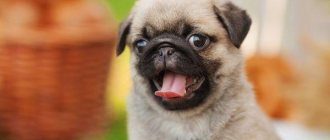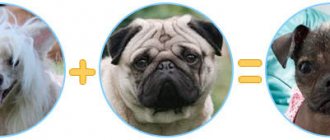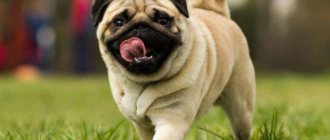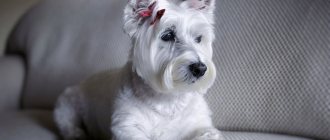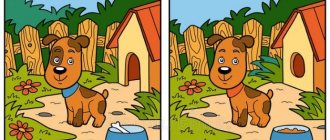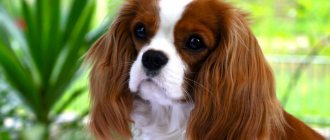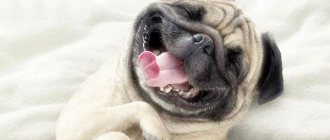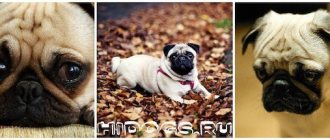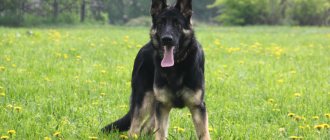- Dog breeds
Pugs are strong and compact dogs. Despite their playful and cheerful disposition, they have a sense of self-esteem. All pugs are distinguished by their intelligence, intelligence and extraordinary devotion.
- Country of Origin : China
- Height at withers : 28-32 cm
- Weight : 6-8 kg
- Lifespan : 12-15 years
- Use : companion dog
History of the breed
Pugs appeared in China during the Han Dynasty (206-200 BC). Some historians believe they are related to the Tibetan mastiff. They were highly valued by the Chinese emperors and lived in luxurious apartments, sometimes even under the guard of soldiers.
Pugs are one of three types of short-nosed dogs known to have been bred by the Chinese: the Lion Dog, the Pekingese, and the Luo Jie, which was an ancient pug. In the late 1500s and early 1600s, China began trading with European countries. The first pugs brought to Europe reportedly came with Dutch traders, who named the breed Pug, which is still used today.
Pugs quickly became favorites of royal courts throughout Europe and even played a role in the history of many of these families. In Holland, the Pug became the official dog of the House of Orange after the Pug was rumored to have saved the life of William, Prince of Orange by warning him of the approach of the Spanish in 1572. When William of Orange (later called William III) traveled to England in 1688 with his wife Mary II to take the throne from James II, they brought their pugs with them.
It is known that black pugs existed in the 1700s because the famous artist William Hogarth was a pug enthusiast. He depicted the black pug and many others in his famous paintings. In 1785, Goya also depicted pugs in his paintings.
The famous Frenchwoman, Josephine Bonaparte, had a Pug named Fortuna. Before marrying Napoleon Bonaparte, she was imprisoned in Le Carme prison. Since her beloved pug was the only “guest” she was allowed to visit, she hid messages in his collar to pass on to her family.
In the early 1800s, Pugs were standardized as a breed with two lines becoming dominant in England. One line was called the Morrison line and was reportedly based on the royal dogs of Queen Charlotte, wife of George III. another line was developed by Lord and Lady Willoughby d'Eresby and was based on dogs imported from Russia or Hungary.
Pugs were first exhibited in England in 1861. The stud book began in 1871 with 66 pugs in the first volume.
Meanwhile, in China, pugs continued to be bred by royal families. When the British captured the Chinese imperial palace in 1860, they found several pugs and brought them with them to England. Two pugs named Lamb and Moss were brought to England.
Pugs became very popular during the Victorian era and were featured in many paintings, postcards and figurines of the period. They were often depicted with wide, decorative collars or large bows on short, thick necks.
What country are you from?
According to the official version, the homeland of pugs is Ancient China, where references to small short-faced dogs are found in early chronicles.
Even in ancient times, there were two breeds of small dogs with short muzzles, one of which was called Lo Jie, and the second - Ha Pa.
The first of them were short-haired, while the second had long and flowing hair. It is believed that Luo Jie became the ancestors of modern pugs, although in ancient times they were more likely to resemble short-haired Pekingese: they had short legs and a stretched body shape.
Pugs supposedly became a separate breed in the 5th century BC. But there have been references to these dogs before. Confucius in his writings described dogs similar to modern representatives of the breed, which accompanied their owners even during their chariot rides.
It is not possible to trace the history of its appearance in our time due to the fact that, by order of Emperor Qin Shi Huang in the 3rd century BC.
All archives and ancient documents that spoke about where these animals came from were destroyed. At the same time, most of the ancient images of the pug were lost. This is interesting! According to another, unofficial version, this breed came to China from India, where references to dogs resembling pugs are found in the epic Mahabharata. And, if this is really so, then the history of these dogs turns out to be more ancient and is pushed back into the past by several thousand years.
Pug: breed features
- Pugs are stubborn and difficult to train. It is recommended to train with other dogs.
- Pugs cannot tolerate heat and high humidity due to their short muzzle.
- When your pug is outside, monitor him closely for signs of overheating.
- Pugs are domestic dogs and should not be kept in a yard.
- Despite their short fur, pugs shed heavily.
- Pugs wheeze, snort and snore loudly due to the structure of their faces.
- Pugs are susceptible to such a specific disease as chronic corneal erosion, so it is necessary to pay great attention to the condition of the eyes.
- Prone to obesity.
- Pugs need constant human contact. If you have a pug, expect him to follow you around the house, sit on your lap, and sleep in the same bed with you.
History of the pug in Russia
The pug first appeared on the territory of our country at the end of the nineteenth century. However, in the post-revolutionary period, the breed almost completely disappeared, and only through the efforts of a few domestic breeders, a little less than forty years ago, it was possible to breed pugs on a professional level.
In the very first breeding work, only five dogs were used, but after nine years it was possible to obtain about eight dozen beautiful, healthy individuals that fully met breed standards. From that moment on, clubs and various nurseries specializing in pug breeding began to actively open, as well as exhibition shows of regional and international class. Russian pugs deservedly enjoy a good reputation abroad, which is why they are very popular among foreign connoisseurs of the breed and dog breeders.
This is interesting! The pug currently owes its appearance to English breeders who carried out very serious breeding work. The unified breed standard was adopted back in 1888, but underwent some changes in 1970.
Return to content
Training and education
Pugs are friendly and sociable dogs, but they are quite stubborn, so training them seems to be a very difficult task, without a guaranteed result. Submitting a dog doesn't always work. The principle of complete submission of the pug to the owner is an outdated method. This theory was formulated based on observations of packs of wild wolves, but they were kept in captivity and, of course, experienced stress. The stress condition forced wolves to show aggression towards each other, but in the wild they do not show aggression to each other - they live together and interact with each other. You need to perceive yourself as the more experienced and mature member of the pack, who is responsible for guiding the new member (pug puppy) and teaching him good behavior, as well as correcting him if necessary. It is important to remember that pug puppies learn a lot on their own. They are very inquisitive, love to explore new territories and, of course, experiment. Puppies tend to repeat actions they enjoy (like playing with a toy). They do not repeat actions that cause them pain (for example, destroying a nest and getting bitten). If your pug puppy misbehaves, ignore him and praise him when he does the right thing. Reward your puppy for following commands and good behavior. Do not neglect these tips. After all, constantly hearing “you can’t” all day long is unbearable. This is a small child who wants to know everything and get his portion of treats as a reward for not eating your favorite rug, going to the toilet outside, bringing you a ball, and so on.
Set rules and monitor their implementation
It's worth enrolling your pug puppy in obedience training classes. These classes will allow you to understand exactly what actions will allow you to control your dog’s behavior. You will be able to spend more time with your puppy, establish contact and socialize around other dogs.
Adviсe
- Training a pug puppy should be done with the help of positive motivation; watch carefully special films about this technique. The Canine Translator film series from National Geographic is suitable.
- If you need to leave your puppy at home alone for 2 hours or more, then ask someone to come to him.
- Be sure to schedule your pug puppy an appointment with the vet as soon as possible. The doctor will carefully examine him and give him vaccinations that will protect him from dangerous diseases.
History of the Pug in Europe
After it was possible to establish trade relations between the countries of the continent and the Far East, the exchange of various animals gradually began. This, from the point of view of scientists, explains the entry of pugs into Europe. There is a version that dogs of this breed were brought over four hundred years ago by Dutch sailors. Many Europeans are still inclined to think that the pug is a dwarf descendant of the bullenbeitzer dog. The first Dutch breeders, due to some external similarities, nicknamed the pug the Chinese mastiff.
In England, pugs were initially called “Dutch Pug” or Danish pug . It is generally accepted that the word “pug” is an abbreviation of the English word pugnacious, and therefore is translated as “pugnacious.” However, there is an opinion, confirmed by Howell's dictionary, that such a translation is incorrect; therefore, the word “pug” in the name should be interpreted as “dear” or “dearly loved.” Italian breeders, and a significant number of pugs were kept by residents of Venice, affectionately called their pets “mascherino” or “little mask”. And the French gave this breed the name “little mastiff”.
Pugs were very revered by the European nobility, so such pets were almost constant companions of socialites, including the Marquise de Pompadour and Marie Antoinette. Apricot and fawn colored pugs were favorites of Queen Victoria . The nicknames of the pets of the reigning person are Olga, Minka, Pedro, Venus and Fatima. And the favorite of Empress Josephine, the pug Fortuna bit Bonaparte when he tried to get too close to his royal lover.
This is interesting! It is a fact that it was the pug who became the savior of the ruler of Holland, William the Quiet, during the period of the military campaign with Spain. Scratching and barking, the pug woke up the king during an enemy attack on the sleeping camp, thanks to which he received the status of an official dog in the House of Orange.
Return to content
Attitude towards children and pets
Pugs love children. Although the Pug is small, it is not as fragile as some other small dog breeds, making it a good choice for families with children. Always supervise any interactions between dogs and small children. Teach your child never to approach any dog while it is sleeping or eating, or to try to take food from it. No dog should be left unattended with a child.
A properly trained and socialized pug will get along well with other pets.
If you decide to get a dog, especially a puppy, then get ready for the following: you will often have to clean up little mistakes after the puppy; investments will be required in annual vaccinations, feeding, toys, ammunition, etc.; any animal requires attention and communication, so if you don’t have time, then there will be no mutual understanding with your pug puppy. Big changes are coming in your life. If you can handle this, you will find a loyal friend for life.
European Pugs
Fashion trends for pugs in European countries began in the 16th century, after they were imported by a Dutch trading company. Europeans, both noble and simple, quickly fell in love with these restless, energetic dogs. Pugs have been immortalized in works of art - they were depicted in paintings, described in books, etc.
Several centuries later, pugs became a sign of wealth and nobility. Pugs appeared in royal families, entire houses were created for them, and servants were hired. For example, in Napoleon’s family there lived a pug, famous for the image of a black mask on its face.
Pug Training
The pug is a decorative breed that does not undergo testing for working qualities. In addition, pugs are not trained in the traditional sense of the word. If you are too persistent, the dog will be offended and leave. However, there will be nothing to punish him for - he will not start tearing books and chewing shoelaces, the reason for this is both the nature of the breed and the structural features of the teeth. In the case of a pug, it is more about education. Dogs are intelligent, but their developed sense of self-esteem allows them to cooperate only with those who show them respect.
How was the breed developed?
The close similarity of pugs to Pekingese has been proven by scientists.
At first, the opinion was formed that the pug was bred by the Chinese nation and crossed with long-haired Tibetan dogs, in particular the crossing was carried out with the Lhasa Apso.
All this was done with the aim of breeding the Pekingese.
But later research was carried out, and scientists came to the conclusion that the Pekingese is an ancient breed, the roots of which extend to Tibetan dogs, brought to China a long time ago.
Only through genetic research and DNA analysis was it possible to establish the ancient origins of the Pekingese. The origin of the pug refers to two versions:
- Breeding the breed from short-haired Pekingese;
- Crossing Pekingese with short-haired dogs.
Unique abilities of a pug
Sometimes pugs really amaze their owners, demonstrating abilities that, it would seem, are not characteristic of dogs. So, representatives of this breed can:
- use the front paws as hands - when getting something from under the bed, most likely the dog will not even try to stick its head there, but will simply use its front limbs like a person’s hands;
- stretch out your paw for a treat and even move your toes;
- knocking on the door quite persistently.
These cute, unusual-looking dogs have also made their mark on cinema, appearing in films such as Men in Black and Kingsman: The Secret Service.
Today and always
For more than 2,500 years, these dogs have been bred as companions and perform excellent tasks assigned to them. The breed has a very large and constantly growing number of fans. However, recently there has been a tendency to cross them with other dogs, such as beagles. The resulting interesting creatures are known as puggles. While any inbreeding is a one-time litter that does not go further into reproduction, these are considered purebred dogs.
It should be noted that great popularity has a bad effect on the purity of the breed. Due to the demand for offspring, unscrupulous breeders create entire puppy mills without caring about the health of mothers and babies. The main thing is quantity. Of course, when choosing a future family member, it is better to get to know the breeder better.
Pug Care
Pug coat care
It is best to brush your pug with a stainless steel toothed comb once a week. This will help partially get rid of the hair, which, if not done, will be scattered throughout the house. Regular brushing will give your pug a well-groomed appearance.
However, don’t expect miracles, pugs shed a lot! In the summer, when I brush my beige pug, his undercoat, like poplar fluff, flies all over the apartment.
Some owners brush their pugs every day because it helps reduce the amount of hair in the house. Pugs generally love to be brushed and some even look forward to it. Brush your Pug in the direction of the hair growth, using light strokes and without applying too much pressure.
Typically, pugs are bathed once every 3 months. You can choose your bathing routine based on your Pug's needs and activity levels.
Caring for wrinkles on the face
Grooming is one of the most important components of pug care. The folds on a pug's face are magnets for bacteria. They get in there easily because the pug spends a lot of time in the food bowl, outside in the grass, etc. Plus, the folds on the pug's face collect discharge from the eyes.
When cleaning the folds, make sure that no infection or fungus has developed there; if this happens, contact your veterinarian; usually such problems are not difficult to treat. In addition, “all the crap” that accumulates in the folds will cause an unpleasant odor from the pug, which is an extra motivation for owners to clean the folds regularly.
Caring for folds is easy, especially if you have an obedient pug; it is best to accustom your dog to this procedure from childhood. You can use lotion for children that does not contain alcohol and is odorless. Take your pug, gently lift the crease and rub the inside above the nose and then under the eyes with a cotton pad containing lotion. Continue until the cotton pad comes out clean. Finally, you can apply a thin layer of Vaseline inside the crease above the nose to protect this sensitive area. The frequency of this procedure depends on the condition of the folds, but at least once a week.
In addition, like other dog breeds, the pug needs to have its ears, teeth and nails trimmed.
Despite the fact that pugs do not need much physical activity, pugs still need activity in the form of live games and daily walks.
One of the main features of the pug is its unusual, expressive eyes. They require close attention and special care. When walking, make sure that the dog does not damage them with thorny plants and branches, so that there are no cats nearby. At home, your pug's eyes should be washed carefully. In cold weather, a pug should be walked in overalls; low temperatures are not for this dog.
Ancestors of pugs
As has already become clear, the breed originated in China and gained great popularity at the court of the emperor, and then throughout the nobility. They are also mentioned in the treatises of Confucius. He described small, flat-faced dogs that were created around 400 BC. e. There are surviving images of animals wearing collars with bells. The history of the pug breed has experienced peaks of glory and oblivion, like many others.
As far as one can judge, its unprecedented popularity dates back to the 17th century. At this time, images of the ancestors of modern pugs appear on engravings and figurines, many of which have survived to this day. In those days, dogs did not yet have such deep wrinkles as modern dogs. But the drawing was already clearly visible. Experts believe that from the 16th century they can be considered fully developed dogs, although the history of the pug breed begins long before that.
Around the 16th - 17th centuries, these pets became favorites of women from high society. It was considered good form to keep this creature at home with a cute face that resembles an exotic monkey and sets off the beauty of the owner. They warmed the owner in her chambers, so they were called boudoir dogs.
Pug Nutrition
You can't call a pug a picky dog; rather, he is prone to overeating. He will ask you for tasty morsels, stretching out his front paw, wiggling his fingers to convince him (a feature of the breed!), and you yourself won’t notice how many of these morsels you will give away to please your pet. Don't want your dog to look like a sausage? Then - meals three times a day in small portions, a balanced diet and no snacks.
When accustoming your puppy to feeding, you need to lightly push him towards the bowl with the mixture. He will lick his lips first and then perhaps start lapping. At the age of 3–4 weeks, puppies are given complementary foods 2 times a day, 4–5 weeks – 3 times, 5–7 weeks – 4 times.
Some dog breeders feed their puppies raw minced meat. However, this is not suitable food for them, since it does not cause active work of the stomach and intestines and is not completely absorbed.
At the age of 4–5 weeks, the puppies are transferred to dry food; at the age of 5–6 weeks, they are gradually taken away from their mother, leaving her with her only at night.
So, gradually the puppies stop needing mother's milk and learn to accept solid food.
Starting from the 5th week, puppies begin to be fed milk semolina porridge, and from the 6th week - oatmeal soup cooked in meat broth. The meat must be chopped.
After 6 weeks from birth, puppies begin to add vegetables to their food. You can give them finely chopped raw meat, fish fillet, cottage cheese, yogurt, raw eggs, grated carrots.
We advise you to read: Brussels Griffon Dog Breed
Dog breeders recommend using fish oil as a vitamin supplement. You should start with 3-5 drops daily. At the age of 3 months, puppies can be given 2-3 teaspoons of fish oil and 1-2 pinches of chopped fresh herbs. If a puppy has an upset stomach, fish oil is excluded from the diet.
Calcium glycerophosphate can be given to puppies as a mineral supplement. In the first 3 months of the animal’s life, feeding is given at 0.5 tablets; at 7–8 months of age, the dose of calcium glycerophosphate in the puppy’s diet should be increased to 5 tablets.
There are several basic rules that must be followed when feeding a puppy:
- You should not feed the puppy from your hand or spoon, as in the future the dog will refuse to eat from the bowl;
- the puppy must know its place in the house. You should not give him food at the table during lunch and in the kitchen at the moment when they are cooking;
- if a dog refuses the food offered to it, it is not recommended to replace it with another type of food, since the animal, having learned that it can get something more tasty, will subsequently refuse regular foods;
- You should not force-feed your dog if it refuses food. The reasons for this are often poor quality food or the presence of some disease in the puppy;
- You should not teach your puppy to catch thrown food in the air. Food must be placed in a bowl. In this case, it is necessary that the dog does not pick up anything that falls on the floor.
